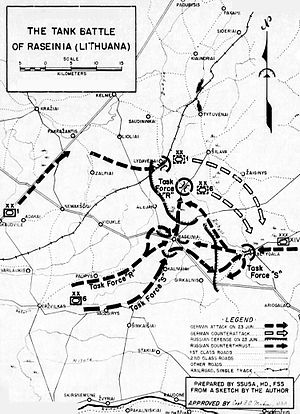| Battle of Raseiniai | |||||||
|---|---|---|---|---|---|---|---|
| Part of the Eastern Front of World War II | |||||||
 Map of the battle | |||||||
| |||||||
| Belligerents | |||||||
|
|
| ||||||
| Commanders and leaders | |||||||
|
| |||||||
| Strength | |||||||
| 235–245 tanks[1][2][f] | 749 tanks[3] | ||||||
| Casualties and losses | |||||||
|
2/3 of the (6th Panzer Division and 4th Panzer Group), a few cannons and trucks |
704 tanks (crewmen either killed or captured)[3] | ||||||
The Battle of Raseiniai (23–27 June 1941) was a large tank battle that took place in the early stages of Operation Barbarossa, the German invasion of the Soviet Union. The battle was fought between the elements of the German 4th Panzer Group and the Soviet 3rd Mechanized Corps with the 12th Mechanised Corps, in Lithuania, 75 km (47 mi) north-west of Kaunas. The Red Army tried to contain and destroy the German troops that had crossed the Neman River but was unable to prevent them from advancing.
The result of the battle was the destruction of most of the Soviet armoured forces of the Northwestern Front, which cleared the way for the Germans to attack towards the crossings of the Daugava River (Western Dvina). The fighting around Raseiniai was one of the main battles of the initial phase of Operation Barbarossa, referred to in Soviet historiography as the Border Defensive Battles (22–27 June 1941) and formed part of the larger Soviet Baltic Strategic Defensive Operation.
- ^ Rosado & Bishop 2005, p. 66.
- ^ Taylor 2003, p. 14.
- ^ a b Glantz 2002, p. 32.